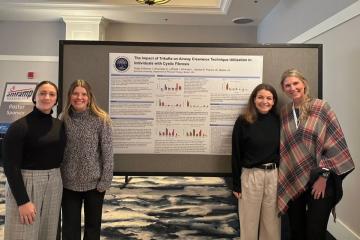“The most rewarding aspect of what a PT does is being able to change someone’s life,” says Nina Testa ’23, ’25DPT, currently an outpatient physical therapist (PT) at the Northeast Rehabilitation Network in Haverhill, Massachusetts. “We help people with chronic conditions and help them navigate their life and their ‘new normal.’ I find this so impactful and personally fulfilling.”
Testa was drawn to the discipline of physical therapy at a young age. In middle school, the mother of one of her friends was a PT and often brought Testa along when she performed home care. “I became so excited about the profession,” she recalls. “I always knew that I wanted to help people, but that I couldn’t do a desk job or sit alone in a cubicle. The active, scientific, nerdy piece of it greatly interested me.”
An Accelerated Education at Simmons
“Being a graduate student at Simmons is a lot of work, but it’s worth it. I never felt alone … [and] I always felt like I had a path,” Testa says. “The quality of education at Simmons is something to note.”
When applying for colleges, Testa initially wasn’t interested in attending a “city school.” However, upon learning about the University’s intimate community within the larger city of Boston (also conveniently close to her family), she decided that Simmons would be the ideal institution for her.
Testa was also drawn to the accelerated educational options, namely, the Health and Exercise Science + Physical Therapy (3+3) program. She received a scholarship for the duration of her six years at Simmons.
As her classes became increasingly specialized, Testa appreciated the small student-to-faculty ratio. “The small class size at Simmons is an incredible perk. I’m not sure I would be able to succeed as well without it. I have personal connections with many of my professors … Every single one of the Department of Physical Therapy faculty is an amazing asset,” she says.
One of Testa’s favorite courses was an informal reading group, “Therapeutic Experience,” supervised by Professor and Director of the DPT Program Justin Beebe, which explored the issues of pain, trauma, and healing. “This discussion-based course was very student-led … and it’s really important to think about the effects of putting your hand on somebody,” she remarks.
Research on PT and Cystic Fibrosis
Testa’s most recent research project, which she conducted as a DPT student alongside colleagues and Department of Physical Therapy faculty members Isabella Loffredo ’25DPT, Sydney Shumway ’23, ’25DPT, Brandon Santos ’25DPT, Lauren Whitman ’23, ’25DPT, Lecturer Izabella Warren, Professor Beebe, and Associate Professor of Practice Jenna Stuebe Powers, is entitled “The Impact of TRIKAFTA® on Airway Clearance Technique Utilization in Individuals with Cystic Fibrosis.”

As Testa explains, Cystic Fibrosis (CF) “is a progressive disease that can affect multiple body systems but primarily the lungs.” TRIKAFTA is a “miracle drug” for people with this condition.
Prior to the availability of this treatment, PTs worked with CF patients on pulmonary clearance techniques, breathing patterns, manual percussion of the chest wall, and other exercises. “Our research team was interested in how much PTs have to be involved in patients’ care after they’ve taken this drug,” Testa says.
Part of this research entailed creating and administering an online survey. “Simmons has [access to] Qualtrics, which is a very helpful tool for collecting data,” Testa explains. “Unlike Google forms or other platforms, this was very secure and kept everything anonymous, so our team was able to produce a very high-quality survey, and something that other schools may not be able to produce.” With guidance from Professor Powers, who is also a clinical specialist at Brigham & Women’s Hospital in Boston, the team received over 100 survey participants.
“Our results showed that PTs were less needed on a regular basis. However, this population may be shifting toward more aerobic exercise and long-term self-care,” Testa says. “Ultimately, our research found that PTs are still useful in this population, but in a different way.”
Testa and her colleagues presented this research at the American Physical Therapy Association (APTA) annual statewide conference in Norwood, Massachusetts, in 2024, and at the APTA National Combined Sections Meeting in Houston, Texas, in 2025.
“I am typically never exposed to that many people with similar interests, so it was wonderful to talk to people who have been working in hospitals and working with CF patients,” Testa says.
Professional Preparation
“Simmons has a great reputation, so that alone is a great way to enter the work force,” Testa notes. “Everybody in the PT world knows about Simmons.”
That reputation facilitates high-quality clinical placements in local hospitals. “Every placement I had was an incredible experience. I learned so much from my clinical instructors, and they provided so much guidance,” she says.
In addition to clinical experiences at Beth Israel Deaconess Medical Center and elsewhere, Testa completed Simmons’ Interprofessional Education (IPE) Certificate program. For this supplementary program, Testa attended a grand rounds simulation in which PT, nursing, occupational therapy (OT), and social work students and faculty came together.
“The IPE Certificate program teaches us how to work together with other professions … This experience not only looks great on a resume, but it also helps you better care for your patients. It was a great preparation for my career,” she explains.
Throughout her time at Simmons, Testa enjoyed the PT cohort’s “wonderful sense of camaraderie.” They often collaborated on gala events, bake sales, and so forth.
“You really get a small family by the end of your graduate education,” she says. “No matter who you are, at Simmons, people are going to treat you as an equal.”

